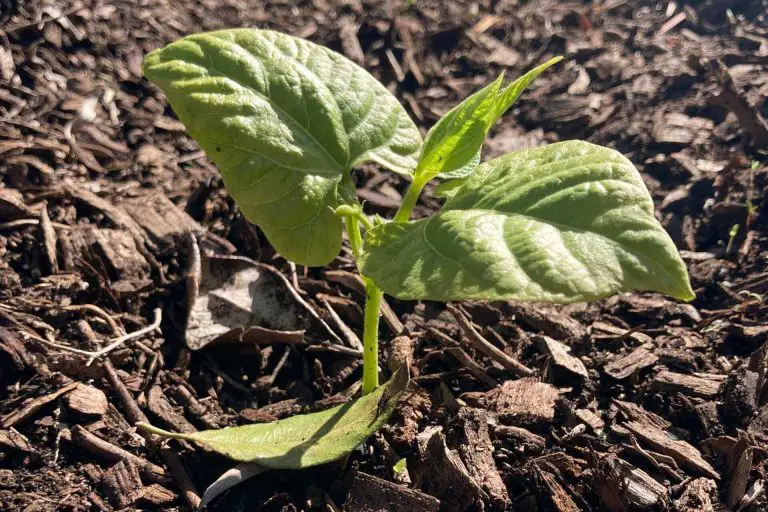7 White Winter Plants For A Cheerful Winter![2023]
Are you interested in planting white winter plants but afraid that the cold will freeze the plants? Fret not.
Despite each plant having different cold tolerance levels, prepare your plants ahead of winter.
To protect your frost-sensitive plants, cover them with polypropylene covers and avoid giving your plants high nitrogen fertilizers as the fertilizers are water soluble in melting snow and heavy rain.
An important point to take note of is that you must choose wisely which beautiful thriving white winter plants to plant first before you take further steps to protect them.
- 7 White Winter Plants
- Winter Jasmine White
- White Winter Pansies
- Winter White Gardenia
- White Winter Aconite
- Winter Rose White Poinsettia
- Winter White Camellia ‘Snow Flurry’
- Winter White Clematis ‘Jingle Bells’
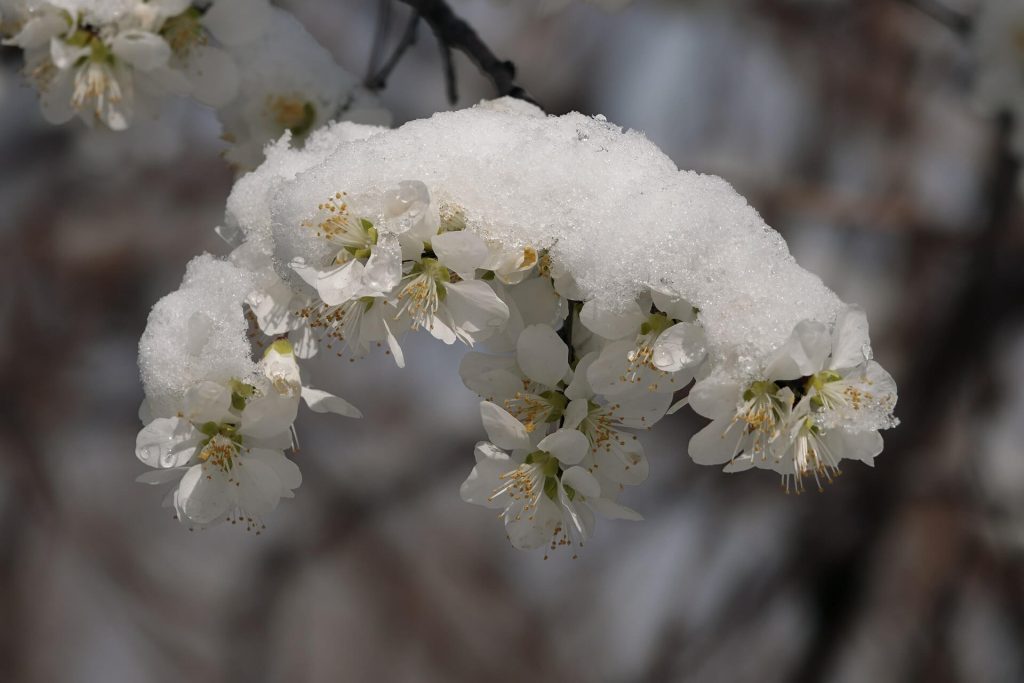
Affiliate Link Disclosure
Some of the links on here are affiliate links and I may earn if you click on them, AT NO EXTRA cost to you. Hope you find the information here useful! Thanks.
Related Posts
- How Much Water Does A Sunflower Need? [+Growing Tips!]
- How To Propagate Orchids [An Easy 2022 Guide]
- All You Need To Know About Propagating Monstera
- 27 Plants That Don’t Lose Leaves In Winter! +Growing Tips [2023]
What Are White Winter Plants?
Winter white flowering plants are annual perennial plants that grow, produce new seeds, and die within a year while some grow back the following year.
In the United States, winter starts on 21 or 22 December and until 20 or 21 March. White winter plants are winter plants and shrubs that bloom from the end of November until the beginning of February.
A similar characteristic of these winter plants and shrubs is their hardiness, the white winter plants are robust and tolerant of extremely low temperatures despite having delicate flowers.
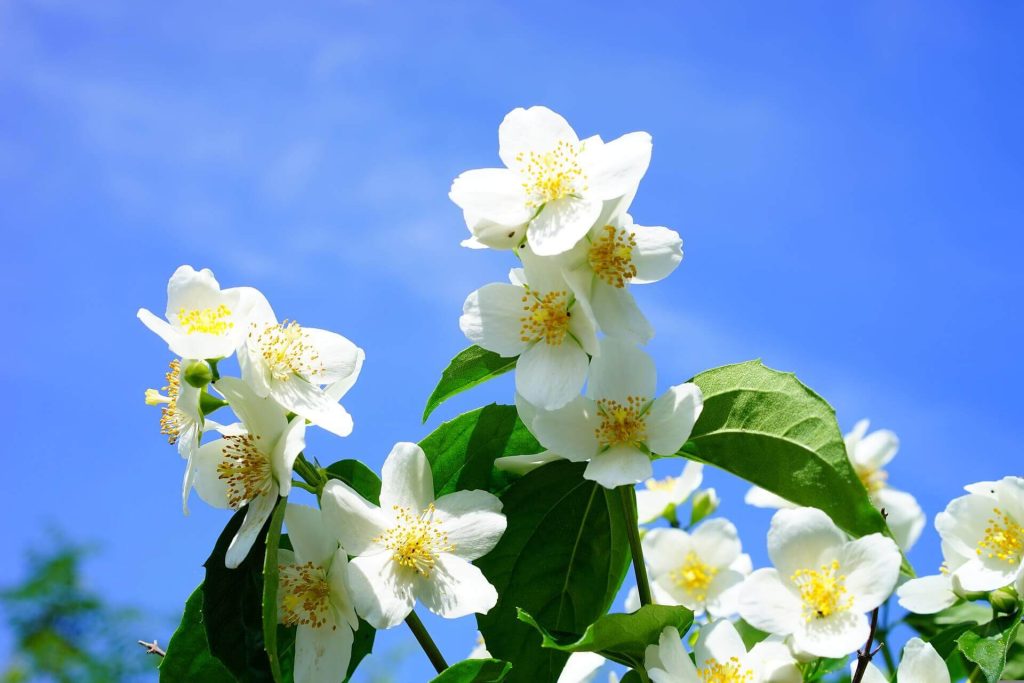
7 White Winter Plants
1. Winter Jasmine White
Winter jasmine white description:
Winter jasmine white pink buds open to the clusters of distinctly fragrant white flowers, which bloom during late and early spring.
Winter flowering jasmine white climbs on trellis around 10 feet or more under partial shade or full sun.
When to plant winter jasmine white:
To ensure strong root development, spring and autumn are the best seasons to plant the winter flowering jasmine white.
How to grow winter jasmine white:
Winter jasmine white plants can grow as tall as 15 feet with support and as tall as 4 feet and as wide as 7 feet without support.
Space out each winter flowering jasmine white by 4 to 5 feet to encourage optimum growth. Add climbing support.
Add mature compost for the winter jasmine white to thrive in the garden. Insulate the outer pots with jute sacks to avoid frost damage.
Avoid overwatering since winter jasmine prefers drier soil. So, water the plant only once a week.
Repotting winter flowering jasmine white in autumn for better bloom. Winter jasmine white blooms in late winter and the flowers will appear before the leaves.
The layering technique is used to propagate winter jasmine by lowering a plant shoot into the ground for new roots to grow while still attached to the parent plant. Separate the shoot after it gains a root system and replants at the new spot.
Harvest the blooms before the flower buds are fully opened in the morning or evening. At an angle of 45 degrees, prune the base of the winter jasmine branches and place it in a vase filled with water.
How to care for winter jasmine white:
Fertilize your white winter plants in spring and summer. Potassium fertilizer increases frost hardiness and pest resistance to the winter jasmine plant.
Nitrogen fertilizer enriches the winter jasmine leaves whereas phosphorus fertilizer aids in lusher blooms.
Regular pruning to trim the leaves neatly can be done with cordless pruners to help maintain the winter flowering jasmine white plant growth.
After the white winter plants’ major bloom cycle, use your best gardening gear to prune until only the young shoots are left for lush flowering in the following year.
Winter jasmine white diseases and solutions:
The white winter bedding plants are deer resistant and loved by bees, aphids, and mealybugs.
Foliar, blight, and fusarium wilt lead to necrosis with discolored halos on the stems and wilted leaves.
Isolate the affected plants first. Remove the damaged and infected plant parts including picking up and disposing of the dropped leaves. Repotting the plant in a new pot with fresh soil.
Use baking soda, neem oil spray, and fungicides to treat the diseases of winter white flowering plants. Avoid overhead watering since the leaves must be kept dry.
The fungus infects winter jasmine white during the moist period while pests attack during dry time.
Yellow or pale green stunted leaves indicate chlorosis. Chlorosis happens due to iron, zinc, and manganese deficiency. Apply chelated nutrient foliar spray to the plant.
Due to insufficient or excessive amounts of water, the flowers of winter jasmine turn brown, form spots, and fall. Make a berm or ridge in doughnut form around the plant at 2 to 3 inches high to entrap rainwater and release it slowly into the ground.
Excessive nitrogen in the soil causes the falling of winter jasmine flowers. The solution is to dilute the excess nitrogen by adding root mulch, wooden sticks, and sawdust to the soil bed.
Due to extreme temperature changes, the flowers may die and fall if the flowers are not pollinated. To aid the pollination process, rub the stigma and anthers of the flowers using a new toothbrush from one flower to another to distribute the pollen.
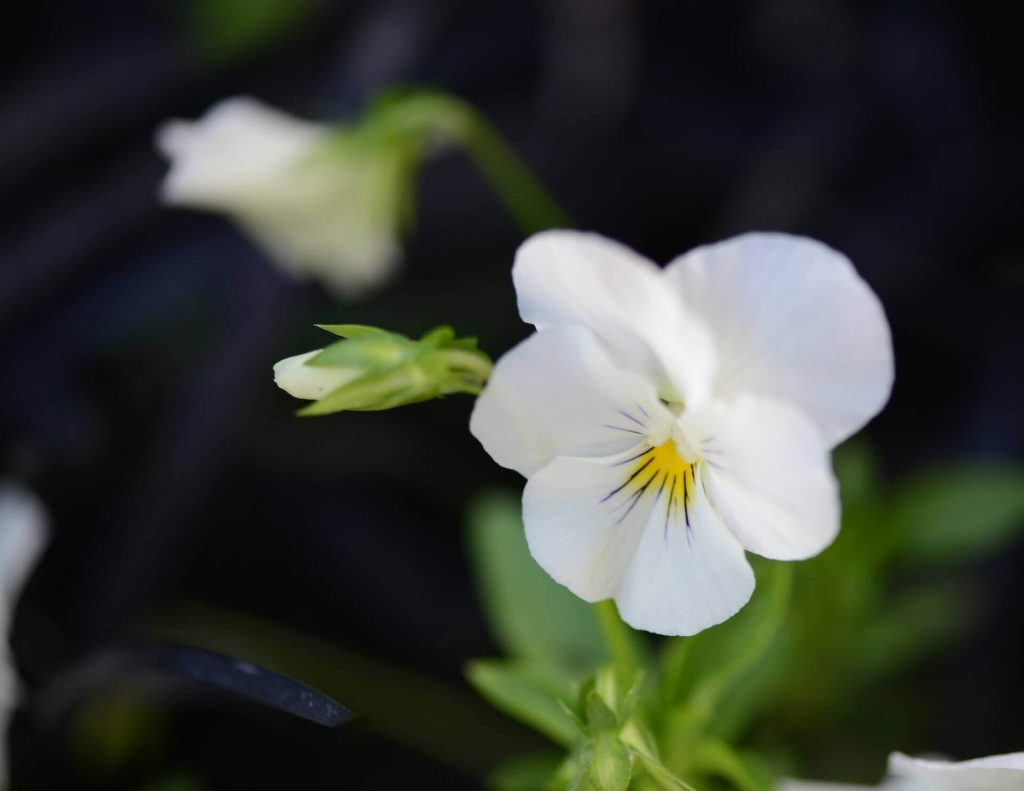
2. White Winter Pansies
White winter pansies description:
The genus name for white winter pansies is Viola x wittrockiana. Its common name is extra-large flower pansies.
Pure white flowers of matrix white pansies have amazing cold tolerance.
When to plant white winter pansies:
If you plant in October or November, grow white winter pansies outdoors first in pots or seed starter trays for about 4 weeks before planting them in their final growing place for winter or autumn, or early spring flowering.
To plant your white winter pansies from the seed, start indoors either in late summer for winter and autumn flowering or in late winter 8 to 10 weeks before the spring for early summer and spring flowering.
How to grow white winter pansies:
Buy white winter plants from the local nursery if you want to enjoy earlier blooms, rather than starting from seed as it takes 1 to 3 weeks to germinate.
White flowers that grow in winter love partial shade or full sun. So, the ideal spot for white winter pansies is where it can get morning sun, yet shaded from the late afternoon heat.
For pansies in portable pots or containers, the pansies must face the south in early spring or fall and move the pansies to face the east during the summer.
Pansies are ready for final planting when their roots touch the sides of seed starter trays. Plant your white winter pansies around 7 to 12 inches apart from each other as they will grow to 6 to 9 inches tall.
To encourage longer-lasting flowers and bigger flower blooms, apply a good feed at a 14-day interval.
How to care for white winter pansies:
Remove the dead flowers to encourage better longer lasting blooms. Do not use high nitrogen fertilizer excessively as it can result in more foliage, instead of flowers.
White winter pansies diseases and solutions:
Black root rot and Pythium root rot diseases happen due to poor drainage, poor sanitation practice, overwatering, and debris. Infected black root rot appears stunted or wilted, developing dark spots on the white pansy roots.
Fungicides, new single-use pathogen-free potting mixes, new containers, nitrogen fertilizers, and good sanitation reduce winter pansy root rot diseases.
Pansies that are affected by genetic mottle pansy syndrome have contorted leaves. It appears normal during the daytime when the temperature is near 80℉ and the night temperature is cool.
The contorted leaves return once the pansies are placed outdoors. The best way is to discard the affected pansy leaves.

3. Winter White Gardenia
Winter white gardenia description:
Gardenia jasminoides ‘frostproof’ is the genus name of winter white gardenia. Winter white gardenia has creamy white flowers and emits a fragrant scent at night.
When to plant winter white gardenia:
Plant winter white gardenia during autumn or spring to provide sufficient time for the root to harden before winter.
How to grow winter white gardenia:
Winter white gardenia can grow as tall as 5 feet or more and 3 to 4 feet wide if left untrimmed. It grows best when the daytime temperature is between 65℉ to 70℉ and night time temperature is between 60℉ to 65℉.
When planting winter white gardenia, dig holes that are twice wide and deeper than the root ball. Space out 2 to 2 ½ feet from each plant for hedge-type planting or 5 feet apart on white winter bedding plants ground.
Add manure compost to the site before planting winter white gardenia. Water it before putting pine straw or compost around the plant.
These winter white flowering plants can tolerate 28℉ to 32℉ temperature during the mild freeze, 70℉ to 75℉ in the daytime, and 60℉ at night time.
Cover gardenia plants with a transparent frost-proof cover or cardboard box to protect the branches from breaking due to the snow weight.
Winter white gardenia starts blooming in mid-May and continues blooming until late summer and early autumn in warmer climates.
To propagate gardenia, cut 4 inches of stem below the leaf in early spring and dip its end in root hormone. Leave the cutting in mixed perlite and potting soil pot. Transplant the cutting into a bigger pot once the root forms.
When harvesting, do not touch the gardenia blossoms with bare hands as they may wilt or bruise. Cut the stems at 45 degrees angle to absorb water and remove all bottom leaves.
How to care for winter white gardenia:
Gardenia plant needs more care than other white flowers that grow in winter.
Keep winter white gardenia soil moist to avoid root shrinkage and cracking. Do not fertilize the plant in autumn or summer and right after transplanting as it contributes to the spurt of frost-tender growth.
Prune winter white gardenia by two third of the new growth in autumn or late summer after flowering has stopped. When the branch tip becomes black from frost or dying, prune 5 centimeters below the damage with sharp pruning shears.
Winter white gardenia diseases and solutions:
Powdery mildew, root rot, stem canker, mealybugs, white flies, aphids, nematodes, and spider mites affect winter white gardenia. Colder temperatures cause winter white gardenia leaves to burn, buds to drop, and other damage.
Water the gardenia first before applying insecticidal oil on the leaves to control spider mites.

4. White Winter Aconite
White winter aconite description:
The family name for white winter aconite is Eranthis. Its flowers are white or yellow. Eranthis pinnatifida or better known as Japanese winter aconite flowers are white with blue-violet stamens.
The stems of these white winter plants change colors from green to bronze in the snow during early spring, between February and March.
When to plant white winter aconite:
White winter aconite tubers are best planted during autumn between September and October.
How to grow white winter aconite:
These white winter plants can grow up to 6 to 8 inches tall. The white winter aconite flowers bloom in late winter until early spring.
Grow white winter aconite from seedlings or self-seed. Leave it undisturbed as it will disintegrate by itself in mid-spring after its cycle is over.
Before planting, soak the aconite tubers overnight in water. Plant the tubers at a distance of 5 to 20 centimeters from each other at 3 to 5 centimeters depth.
After pollination, white winter aconite fruits ripen and open in May to disperse their seeds from the fruits using rain. The plant dies in summer and thrives in the soil as a bulb that will grow until the next spring.
White winter aconite plants can be propagated by seed or division. Propagation by division can be done by digging the white winter bedding plants after the end of the blooming cycle and dividing the tubers into clumps before replanting at new spots.
Harvest winter aconite fruits and seeds between April and May. Dry the seeds to use for the next planting.
How to care for white winter aconite:
Water the winter white flowering plants regularly during dry and warm spring.
When the winter aconite flowers have reduced and the leaves become prematurely yellow, fertilize it from March.
White winter aconite diseases and solutions:
White winter aconite is very poisonous. Symptoms of winter aconite poisoning are cardiac arrest, nausea, and vomiting.
A non-toxic alternative to poisonous winter aconite is white petunia. White petunia is a great option to add similar vibrant white flowers that grow in winter into your garden.
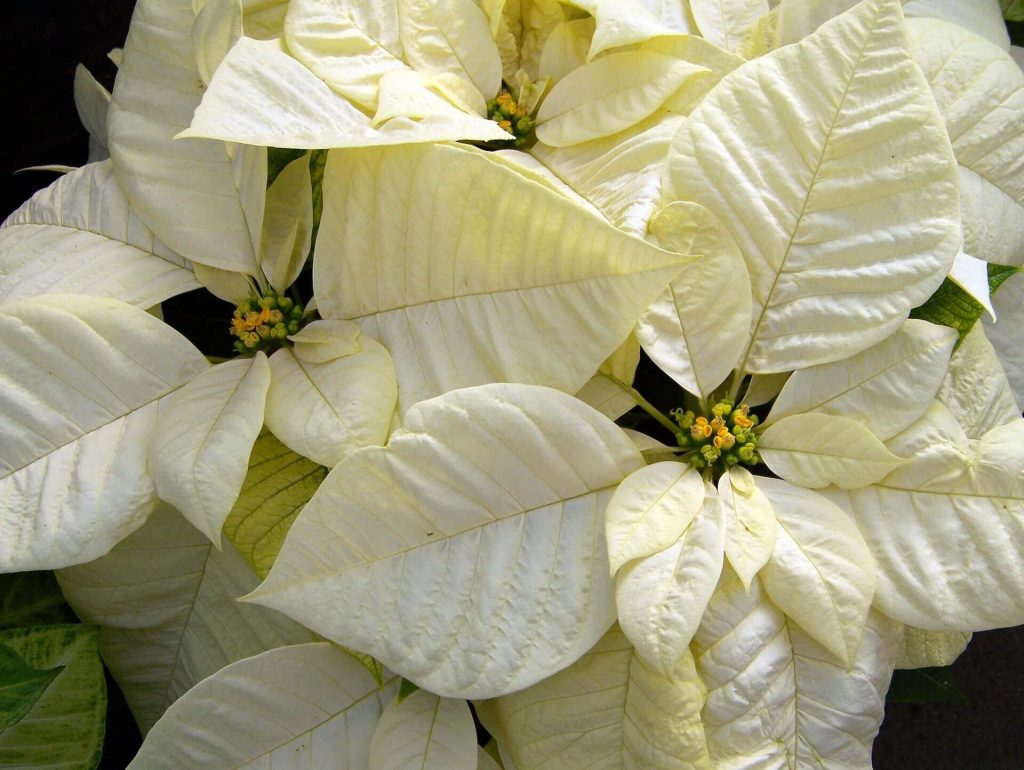
5. Winter Rose White Poinsettia
Winter rose white poinsettia description:
The genus name of winter rose white poinsettia is Euphorbia pulcherrima. As compared to regular poinsettias, winter rose white poinsettias are shorter. The bracts and leaves are smaller and tend to curl inside.
Winter rose white poinsettia has pink tip white flowers. The bracts of the poinsettia plant are the modified leaves. The actual flowers are cyathia, which are the small yellow clusters in the center of the bracts.
When to plant winter rose white poinsettia:
Winter rose white poinsettia blooms in the winter season, from December until January. It only lasts for eight weeks, unless you want to flower it again.
How to grow winter rose white poinsettia:
Rose poinsettia is one of the winter plants and shrubs that can grow up to 12 feet tall.
An important point to take note of is that winter rose white poinsettia plants prefer bright indirect light from January to late September.
To propagate winter rose white poinsettia plants, use 3 inches to 4 inches of new stem cuttings with mature leaves.
How to care for winter rose white poinsettia:
The winter rose white poinsettia plant requires six hours of daylight and a daytime temperature of 60℉ to 70℉, and 55℉ nighttime temperature.
Before watering the winter rose white poinsettia plant again, allow about 50% of the soil to dry.
Underwatering causes the rose poinsettia leaves to droop whereas overwatering causes only the green leaves to fall off.
Fertilize the rose poinsettia plant once a month from late February until December if you intend to keep it past the Christmas season.
For the rose poinsettia to flower again, keep it in total darkness from 5 pm to 8 am around early October until the bracts start to show color in early to mid-December.
Cover the winter rose white poinsettia plant since slight light exposure and nighttime temperature above 70℉ to 75℉ prevent flowering.
Slowly reduce the amount of water after the rose poinsettia leaves have fallen off in April. After 2 weeks, move it to a colder spot with a temperature of 60℉.
Trim the stem 4 inches above the soil and fertilize it after you see new growth by the end of May. In late June, move the white flowers that grow in winter outdoors under indirect sunlight for an hour.
Trim the new stems that appear in mid-August. Fertilise the winter rose white poinsettia in summer and spring.
Winter rose white poinsettia diseases and solutions:
Winter rose white poinsettia is not poisonous and not toxic. However, if the leaves are eaten, it causes stomach discomfort, vomiting, diarrhea, and pet drooling.
The milky sap from rose poinsettia causes itchiness, swelling, skin redness, and latex allergy.
Spray neem oil on winter rose white poinsettia plants to prevent spider mites. Other pests that love rose poinsettia are mealy bugs, fungus gnats, and whiteflies.
Powdery mildew occurs when fungus forms white colonies on bracts. Effective fungicides to control powdery mildew on rose poinsettia are triflumizole, piperalin, triadimefon, trifloxystrobin, and myclobutanil.
Poinsettia scab is characterized by spots that turn from white to brown centers, red to purple rim, form a yellow halo, and super elongated canker.
Mancozeb, chlorothalonil, triazoles, copper hydroxide, and strobilurins are effective against poinsettia scab.
Pythium causes winter rose white poinsettia root rot after cuttings have been planted. The severely affected cuttings will wilt and die rapidly.
Peat moss, high soil moisture, soilless potting media, excessive fertilizer, and water supplies may contain and cause Pythium.
To prevent Pythium root rot, biological control agents, fungicides, sanitation practices, disinfection, water treatment, and usage of pathogen-free potting mixes are essential.
Fungicides like propamocarb, etridiazole, and mefenoxam or metalaxyl are registered for use on poinsettias in the United States.
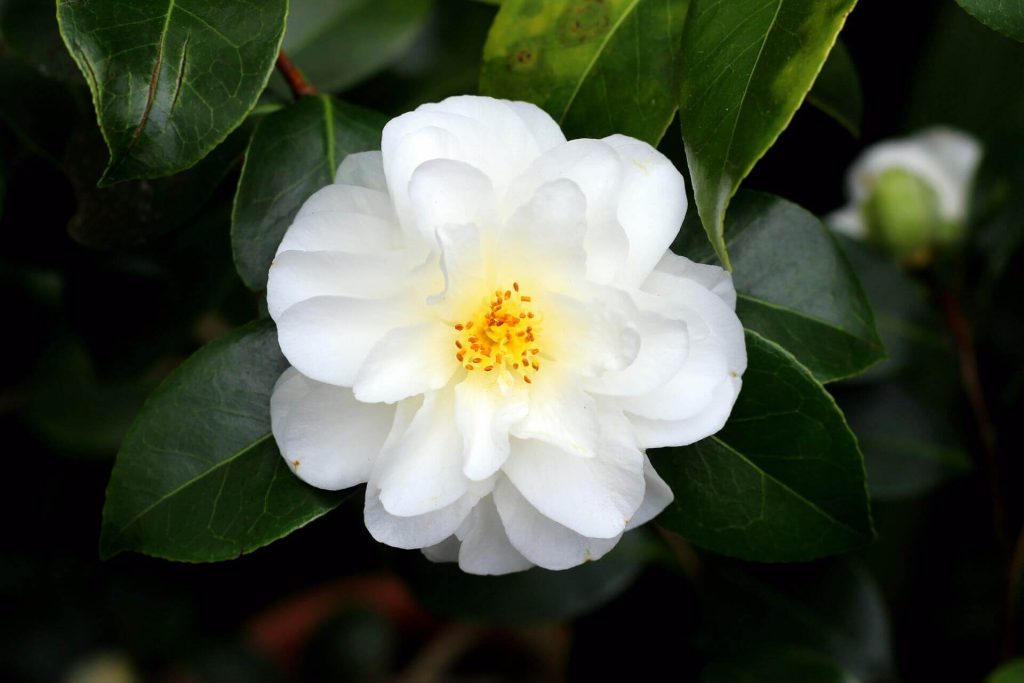
6. Winter White Camellia ‘Snow Flurry’
Winter white camellia ‘snow flurry’ description:
The non-fragrant white flowers of winter white camellia ‘snow flurry’ with a yellow center is a hybrid between the cold hardy Camellia oleifera ‘plain jane’ and flower-form camellia ‘frost princess’.
When to plant winter white camellia ‘snow flurry’:
For northern areas, plant the white winter bedding plants during spring to provide more time for the camellia plant to toughen up before frosty winter.
How to grow winter white camellia ‘snow flurry’:
These winter plants and shrubs can grow up to 5 to 7 feet tall and 3 to 5 feet wide.
Dig the holes twice as wide as the root balls to allow the roots to branch out. Made 2 to 3 vertical slashes of half an inch depth with a sharp knife from top to bottom of the root balls.
Mix the root mulch, compost, and peat moss into the soil until the root ball is covered.
Winter white camellia ‘snow flurry’ blooms for 4 to 6 weeks in mid-autumn to early winter. Spring flowering camellias are prone to frost exposure whereas the flower buds of autumn flowering camellias mature during summer without frost exposure.
Layering to propagate winter white camellia ‘snow flurry’ by putting the branch at the ground and making a nick or two in the buried branches for roots to form. When the new plant is formed, detach it from its parent.
Semi-ripe cuttings can root better by slashing it slightly, taking 5/8 inches strip off the tree bark, and dipping the wounded area in a hormone-rooting compound.
How to care for winter white camellia ‘snow flurry’:
Fertilize camellia ‘snow flurry’ winter flowers that grow in winter once a month until late summer. Excessive fertilization and fertilization later than the end of July cause the flower buds to drop.
Water the winter white camellia ‘snow flurry’ regularly during autumn when the flower buds are forming since it cannot withstand drought.
Start pruning after all frost has disappeared and camellias start flowering. Cut the stems slightly above the previous year’s growth to make the camellia shrubs bushier.
Sprinkle blood and bone meal on top of the root mulch in early autumn when the flower buds form and in early spring before the next growth starts.
Winter white camellia ‘snow flurry’ diseases and solutions:
Two fatal camellia diseases are camellia petal blight and root rot.
Camellia petal blight is characterized by rust spots on the flowers. Remove the infected flowers immediately and pick up the blooms that drop to the ground. Remove and burn the old root mulch before replacing it with a new one.
Practice good sanitation to prevent camellia petal blight.
To avoid root rot, the soil must be well-drained. Copper-based fungicides can kill the fungus.
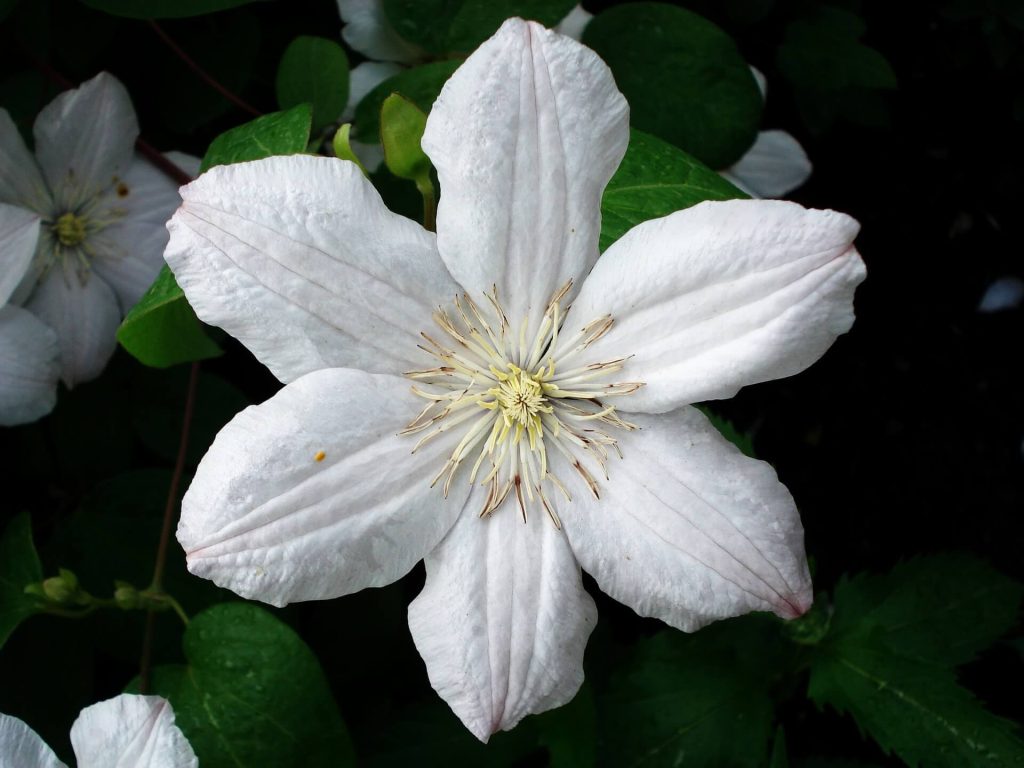
7. Winter White Clematis ‘Jingle Bells’
Winter white clematis ‘jingle bells’ description:
Winter white clematis ‘jingle bells’ are also known as Clematis cirrhosa var purpurascens ‘jingle bells.’
Winter white clematis ‘jingle bells’ flowers have a delicate lemon scent. This evergreen climber bears cup-shaped cream flowers and anthers during late winter and early spring. Its foliage is bronze in winter and becomes mid-green during other seasons.
When to plant winter white clematis ‘jingle bells’:
Plant the winter white clematis ‘jingle bells’ seeds in the seed starter trays during autumn or spring.
How to grow winter white clematis ‘jingle bells’:
Transplant the seedling into the pots or directly into the garden ground after it has grown.
To plant the winter white clematis ‘jingle bells’ in the garden, use blood bone meal, organic fertilizer, coarse grain medium, pine bark, and humus soil together with garden soil to provide better drainage.
Only organic fertiliser is needed as base fertilizer if you grow it in the pot.
Winter white clematis ‘jingle bells’ prefers partially shaded or full sun spots. If you live in cold hardy zones, grow it in pots or containers for an easy move indoors during winter.
Place gravel at the base of the clematis root after the hole has been dug with a hoe for proper drainage. Water the plant afterward.
Make a trellis to support this climbing plant.
Give potassium fertilizer at all cycles. Give nitrogen fertilizer during the clematis ‘jingle bells’ growth and after flowering whereas phosphate fertilizer is when the flower buds start to bloom.
For repotting, the roots of the clematis ‘jingle bells’ seedlings must first be soaked in fungicide water for 20 minutes.
To propagate clematis ‘jingle bells’ in early spring or late winter, make semi-ripe cuttings in early summer or softwood cuttings in spring.
To harvest clematis seeds for reproduction, collect the mature seeds from late summer to mid-winter before it turns dark brown. Over-mature seeds are dormant, which makes the germination period longer once planted.
How to care for winter white clematis ‘jingle bells’:
Winter white clematis ‘jingle bells’ are cold-resistant and cannot survive well in drought and water-accumulated soil. Cover the surface of the soil with nutritional compost to prevent frost from freezing the roots.
The clematis ‘jingle bells’ will start growing after pruning in late winter and early spring and it will have a longer and more vigorous blooming season.
Winter white clematis ‘jingle bells’ diseases, and solutions:
Powdery mildew is characterized by thickened white spots on the upper leaves during hot or humid weather. This can be treated by spraying carbendazim.
Water the base root of winter white clematis ‘jingle bells’ directly without letting the water wet the leaves to prevent powdery mildew in hot weather.
Cut and discard the infected leaves and stems of clematis wilt immediately.
FAQs On White Winter Plants
What Plants Are Best Planted In Winter?
So, what plants are best planted in winter? White winter plants are the best to be planted in the winter as they can brighten up your gardens during winter. For instance, winter jasmine white, white winter pansies, winter white gardenia, winter rose white poinsettia, white winter aconite, winter white camellia ‘snow flurry’, and winter white clematis ‘jingle bells.’
What Are The Best White Winter Flowers For Weddings?
What are the best white winter flowers for weddings? The best white winter flowers for classic elegance weddings or wedding bouquets are winter white roses, winter rose white poinsettia, winter white camellia, winter jasmine white, winter white gardenia, winter white Casablanca lily, winter white tulips, winter white gerbera, and winter white orchid. You can choose a fully open or nearly open flower bud variety.
Which Winter Flowers For Pots?
Suitable winter flowers for pot plantings are:
- Pansies (Viola x wittrockiana)
- Winter flowering heather (Erica carnea)
- Clivia
- White Christmas rose (Hellebores niger)
- Lily of the valley (Convallaria majalis)
- White angel’s trumpet (Brugmansia)
- Bridal wreath spirea (Spiraea prunifolia)
- Azalea (Rhododendron)
- Hydrangea (Hydrangea arborescens)
- Roses (Rosa)
- Dianthus
- African marigold (Tagetes erecta)
Hopefully, after reading this article, you now have a better understanding of white winter plants in general.
With winter plants and shrubs, your bare and dull garden will immensely brighten up your gloomy winter months.
If you are worried about the well-being of your plants during the winter, you can cover them up using the frost protection plant cover. This way you can maintain your flourishing garden even in the dreadful cold weather.
I hope the view of your blossoming white winter garden that you enjoy with a warm cup of hot chocolate, will provide warmth to your heart.
Related Posts









![How To Keep Squirrels Out Of Flower Pots [2022 Guide]](https://aboveandbeyondgardening.com/wp-content/uploads/2021/10/How-To-Keep-Squirrels-Out-Of-Flower-Pots-768x512.jpg)
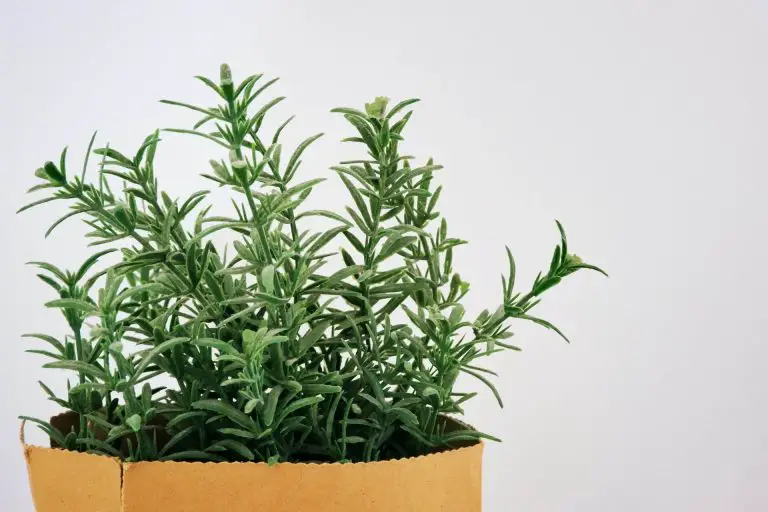
![How To Get Rid Of Pot Worms [A Quick And Easy Guide 2022]](https://aboveandbeyondgardening.com/wp-content/uploads/2021/10/How-To-Get-Rid-Of-Pot-Worms-768x600.jpg)
![27 Plants That Don’t Lose Leaves In Winter! +Growing Tips [2023]](https://aboveandbeyondgardening.com/wp-content/uploads/2022/10/Plant-that-doesnt-lose-its-leaves-in-winter-11-768x512.jpg)
![How To Dig Steps Into A Hill [5 Easy Steps!]](https://aboveandbeyondgardening.com/wp-content/uploads/2021/10/How-To-Dig-Steps-Into-A-Hill-768x512.jpg)
